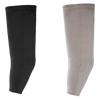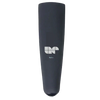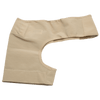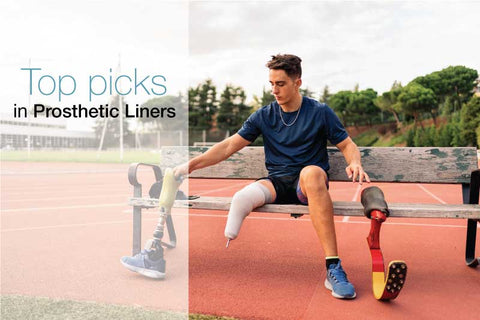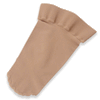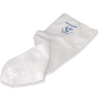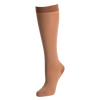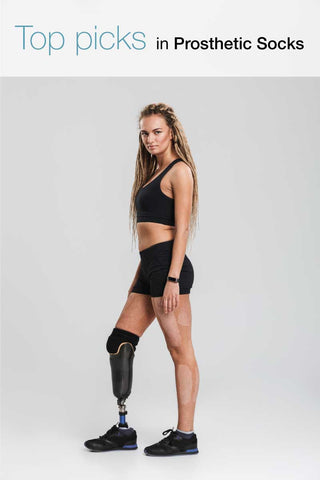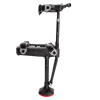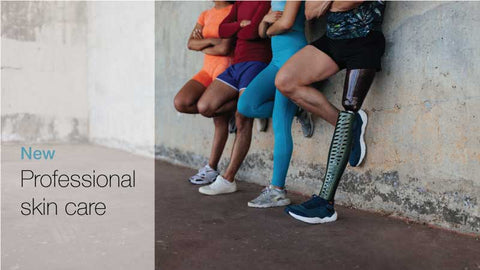No Off-Season: Layering Tips for Amputee Runners in Cold Weather
Reading Time: 6 minutes
___
Summary:
-
Cold weather challenges prosthetic fit, traction, and residual limb comfort
-
Layering system adapted for amputee runners: base, mid, and outer
-
Tips cover moisture control, thermal sleeves, and socket protection
-
Prosthetic care, traction gear, and residual limb prep are crucial in winter runs
___
Winter presents unique challenges for all runners, but when you’re running with a prosthetic leg, those challenges are amplified. Staying active throughout the year is doable, but it takes more than just adding another layer of clothing. You’ll need to consider prosthetic fit, residual limb comfort, cold-weather physiology, running mechanics, and basic layering principles.

In this article, we offer prosthetic-specific care tips, along with layering and adaptation strategies to help you maintain your running streak regardless of the season.
The implications of wearing a prosthesis in cold weather
Generally, when temperatures drop, your running gear needs to manage sweat, subtle temperature shifts, and exposure to wind, rain, or snow. For amputee runners, extra considerations are necessary.
-
Individuals with lower-limb amputations must pay attention to their residual limb skin, which is exposed to dry, cold weather and can become itchy or stiff.
-
Cold, dry air and wet surfaces can accelerate wear and tear of prosthetic components, including corrosion from salt and moisture, and cause fit issues.
-
Concerns such as balance, traction, joint load—especially on the intact limb—and safety on ice or slush become even more critical.
Therefore, layering for a prosthetic runner isn’t just about staying warm; it’s about maintaining prosthetic fit, protecting the residual limb, ensuring traction, and adapting to changing conditions.
A winter-layering system: Adapted for runners with limb loss
The traditional winter running layering system (base ➡️ mid ➡️ outer) remains effective. However, there are more things to consider for runners with prosthetic limbs.
1. Base Layer: Moisture control and limb interface care
Your base layer should wick away sweat, keep you dry, and prevent cooling as you slow down or stop. Avoid cotton, as it retains moisture and can cause chills.
For prosthetic runners, it’s important to keep the residual limb socket interface dry and warm. Excessive sweat beneath the socket can affect fit, cause irritation, and complicate cold-weather adaptation. Wearing a snug, technical synthetic or nylong sheath layer under your prosthetic liner or against your skin helps manage temperature and moisture.
And don’t forget your sound side limb. Layering similarly on your sound side limb and torso ensures your core heat isn’t drained away.
2. Mid Layer: Insulation and buffering
Think of the middle layer as the “personal radiator” layer—designed to trap warm air without causing overheating.
For this layer, consider wearing fleece or merino wool, which may feature thumb loops, quarter-zips, and wind panels. Ensure the insulation is evenly distributed, especially around your socket, as cold surfaces such as prosthetic components can draw heat away.
The mid layer should also facilitate full mobility; since prosthetic running already demands adaptability, bulkier insulation could limit movement. Additionally, remember that your sound side limb may bear extra weight, so keep it warm and supported with items like a thermal compression sleeve or warm tights to help prevent stiffness and joint discomfort in cold weather.
3. Outer Layer: Protection against wind, rain, and snow
The outer layer protects you from wind chill, moisture, and cold gusts. Choosing a jacket with high waterproof and windproof ratings, taped seams, and a good fit over your base and mid layers is essential. But also remember that your outerwear should also provide enough space for prosthetic clearance, such as extra room around your hip or knee for comfortable movement with your prosthetic limb.
Be mindful of exposure to wind and moisture on prosthetic components, as salty slush and wet surfaces can accelerate wear. We suggest regularly inspecting and cleaning the exposed parts of your prosthetic limb.
Lastly, consider visibility and tracking features in your outerwear. During winter, with less daylight and icy conditions, include reflective elements and, if needed, add traction support for safety.
Additional amputee-specific layering and running considerations
Warm up your residual limb before running: A cold residual limb can cause discomfort, stiffness, or shrinkage, which can affect your prosthetic socket fit. In cold weather, residual limb discomfort or stiffness may increase, so a gentle warm-up indoors (such as leg swings and mobility exercises) before heading out can be beneficial.
Sock layering for prosthetic interface: Using warm, breathable outerwear around the socket area can help buffer cold metal or plastic parts. Avoid thick padding that might affect your range of motion. Consult your prosthetist for the best options for you.
Footwear/traction adaptation: On icy or slushy routes, traction is essential. We suggest rubber-soled shoes, cleats, or spiked attachments. This is especially important for runners with prosthetics. Make sure your running shoes or blade have good tread, and that any prosthetic foot or adapter is suitable for colder and wetter surfaces.
Maintenance: Cold weather and road salt increase the risk of corrosion, hydraulics not working properly, and component wear. Regularly check screws and bolts, and clean your prosthesis after exposure to melting solutions.
Adjust expectations and plan layering: Generally, dress as if it’s 10°C warmer than the actual temperature, since body heat rises with movement. For prosthetic runners, this rule still applies, but remember your prosthetic limb may behave differently due to heat transfer, contact surface, or insulation. Monitor your comfort and socket fit during your run and carry a spare layer or cover if conditions worsen. Also bear in mind that you'll generate more heat than "able-bodied" runners.
The bottom line
With careful layering, gear adjustments, and ongoing maintenance, you can remain active even as temperatures drop. The standard winter running layering approach still applies: use your base layer to manage moisture, add a mid-layer for warmth, and wear an outer layer for protection against the elements.
However, for amputee runners, it’s especially important to consider residual limb care, protect the prosthetic interface, ensure good traction and safety, and modify fit and gear according to the colder weather.
With these tips, we hope the cold becomes just another factor to manage rather than a barrier to staying active all year round.
Related Reading:
Tips on Staying Active in the Cold Winter Months
Explore Adaptive Skiing This Winter
A Guide to Winter-Proofing Your Days
A Beginner’s Guide to Amputee Running: Improving Running Form

